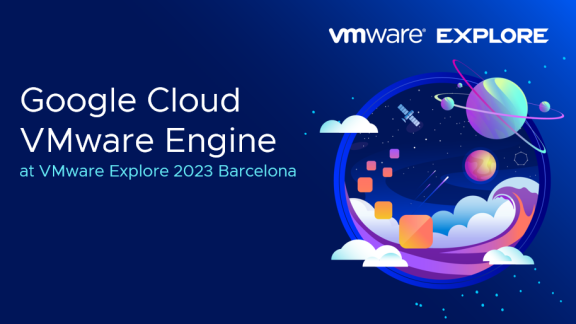Google Cloud VMware Engine reached its two-year anniversary this summer and continues to help customers across many industries speed their cloud transformation journeys. Today I will share the latest capabilities of Google Cloud VMware Engine to support customers in migrating to the cloud and modernizing their infrastructure and applications according to their timeline. You will learn how Google Cloud VMware Engine provides options for running both VMs and containers on the same infrastructure, provides new enterprise capabilities, continues to expand regionally, and more.
First, we are pleased to announce VMware Tanzu Standard edition on Google Cloud VMware Engine to help simplify Kubernetes adoption and management. With this solution, enterprises can accelerate application and infrastructure modernization by quickly adopting containers and Kubernetes technologies with an enterprise-grade, open-source aligned, full Kubernetes runtime platform on top of Google Cloud VMware Engine. VMware Tanzu Standard is sold and supported directly by VMware.
Tanzu Standard includes:
- VMware Tanzu Mission Control, a global control plane, to enable consistent and efficient management of Kubernetes clusters deployed across multiple infrastructure types.
- VMware Tanzu Kubernetes Grid (TKG), which can be deployed on-prem on vSphere, in public clouds, and at the edge. Tanzu Kubernetes Grid provides consistent, enterprise-grade Kubernetes clusters for you to run your modern applications wherever necessary to accommodate business, technical, or compliance requirements.
With Tanzu Standard on Google Cloud VMware Engine, you can:
- Run your VMs and containers on the same infrastructure with a single point of governance.
- Migrate easily with speed, enhance your apps, and run both VMs and containers on Google Cloud VMware Engine, and get private, high-bandwidth, low-latency access to innovative Google Cloud services to gain data-driven insights.
- Deploy a consistent Kubernetes distribution across environments and manage all the clusters via a single control plane.
- Gain flexibility and control and meet security and compliance requirements.
Next, here are other recent improvements.
Cloud Director service for Google Cloud VMware Engine
Cloud Director service supports the management of multi-tenant SDDC services on Google Cloud VMware Engine. With this service, enterprises and certified partners can deliver right-sized cloud resources to your tenants (internal customers or lines of business) with secure separation and control.
Google Cloud VMware Engine as part of VMware Cloud Universal
By bringing Google Cloud VMware Engine, which combines the best of VMware compute, storage, network virtualization, and management technologies with Google Cloud’s next-gen infrastructure and networking, into VMware Cloud Universal, customers gain enhanced financial flexibility, broadened platform choice, and accelerated cloud adoption.
Automation with Google Cloud API/CLI support in public preview*
Users will be able to enable automation at scale for Google Cloud VMware Engine infrastructure operations using Google Cloud API/CLI. This capability will also enable you to manage these environments using a standard set of toolchain consistent with the rest of Google Cloud. If you are interested in participating in this public preview, please contact your Google account team.
New regions and zones
Google Cloud offers regions worldwide to provide customers with global coverage, low cost, low latency, and application availability. Google Cloud VMware Engine nodes are now available in these additional regions and zones:
- New regions: Zurich, Switzerland, Europe (europe-west6); Toronto, Ontario, North America (northamerica-northeast2)
- Additional zones: Ashburn, Northern Virginia, North America (us-east4-b); Sydney, Australia, APAC (australia-southeast1-b).
- Additional regions* are expected in 2023 in Asia, Europe, and South America.
VMware HCX Enterprise now included
Google Cloud VMware Engine now leverages the HCX Enterprise license level by default, enabling the following premium HCX features:
- HCX Replication Assisted vMotion (bulk, no-downtime migration)
- Migrations from KVM and Hyper-V to vSphere
- Traffic engineering
- Mobility groups
- Mobility-optimized networking
This capability gives you the flexibility to configure your clusters to help meet your application-specific licensing requirements and reduce costs. You can set the number of cores available per node in a cluster to meet your application-specific needs during cluster creation.
Single node
You can deploy an SDDC (or private cloud) with a single node for testing and proofs of concept with Google Cloud VMware Engine. Single node private clouds are not covered by SLAs and expire after 60 days if they are not expanded to at least three nodes.
Additional capabilities*
Google and VMware are working on a roadmap to improve scale, availability, and compliance:
- Increasing scale from up to 64 nodes per private cloud to a maximum of 96 nodes per private cloud. This would enable larger customer environments to be supported with the same highly performant dedicated infrastructure and would increase operational efficiency by managing such large environments with a single vCenter server.
- With stretched clusters, a cluster would be deployed across two availability zones in a region, with synchronous replication, enabling higher levels of availability and failure independence.
- Working on adding more compliance certifications – SOC1, Information System Security Management and Assessment Program (ISMAP), and BSI:C5.
I’ve shared the latest capabilities of Google Cloud VMware Engine to support customers in migrating to the cloud and modernizing their infrastructure and applications according to their timeline. Check out the links below to learn more.
Learn more
- Get more information about VMware Tanzu Standard on Google Cloud VMware Engine
- Browse Google Cloud VMware Engine sessions live and on-demand at VMware Explore US to hear the latest news
- Get started with Google Cloud VMware Engine Quick Start activity path full of technical demos
- Visit Google Cloud VMware Engine for more information
*VMware makes no guarantee that services announced in preview or beta will become available at a future date. The information in this blog is for informational purposes only and may not be incorporated into any contract. This article may contain hyperlinks to non-VMware websites that are created and maintained by third parties who are solely responsible for the content on such websites.






